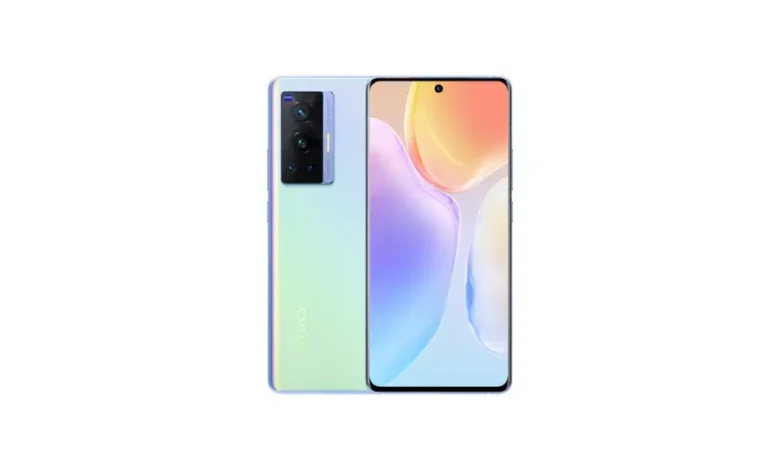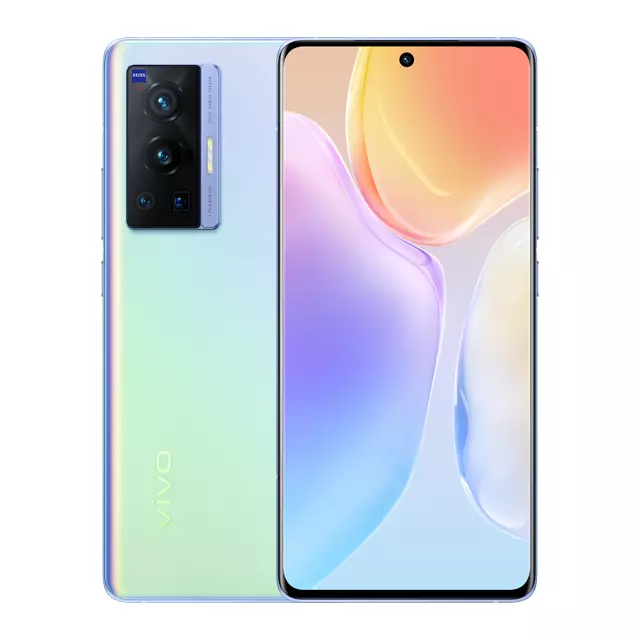

Vivo X70 Pro 5G Full Specifications and Price in United States, Europe and United Kingdom:
| First Release | September 17, 2021 |
| Colors | Cosmic Black, Aurora Dawn |
| Connectivity | |
|---|---|
| Network | 2G, 3G, 4G, 5G |
| SIM | Dual Nano SIM |
| WLAN | dual-band, Wi-Fi direct, Wi-Fi hotspot |
| Bluetooth | v5.2, A2DP, LE, aptX HD |
| GPS | dual-band A-GPS, GLONASS, BDS, GALILEO, QZSS, NavIC |
| Radio | ✖ |
| USB | v2.0 |
| OTG | Yes |
| USB Type-C | Yes |
| NFC | (market dependent) |
| Body | |
| Style | Punch-hole |
| Material | Unspecified |
| Water Resistance | ✖ |
| Dimensions | 158.3 x 73.2 x 8 millimeters |
| Weight | 183 grams |
| Display | |
| Size | 6.56 inches |
| Resolution | Full HD+ 1080 x 2376 pixels (398 ppi) |
| Technology | AMOLED Touchscreen |
| Protection | Unspecified |
| Features | 120Hz refresh rate, HDR10+, 1300 nits max. brightness |
| Back Camera | |
| Resolution | Quad 50+8+12+12 Megapixel |
| Features | Laser AF, gimbal OIS, 5x optical zoom, periscope telephoto, ultrawide, Zeiss optics, Pixel Shift & more |
| Video Recording | 4K Ultra HD (2160p), gyro-EIS |
| Front Camera | |
| Resolution | 32 Megapixel |
| Features | F/2.5, 1/2.8″, 0.8µm, HDR & more |
| Video Recording | 4K Ultra HD (2160p), gyro-EIS (1080p), HDR10+ |
| Battery | |
| Type and Capacity | Lithium-polymer 4450 mAh (non-removable) |
| Fast Charging | 44W Fast Charging |
| Reverse Charging | Yes |
| Performance | |
| Operating System | Android 11 (Funtouch OS 12) |
| Chipset | MediaTek Dimensity 1200 5G (6 nm) |
| RAM | 12 GB |
| Processor | Octa core, up to 3.0 GHz |
| GPU | Mali-G77 MC9 |
| Storage | |
| ROM | 256 GB (UFS 3.1) |
| MicroSD Slot | ✖ |
| Sound | |
| 3.5mm Jack | ✖ |
| Features | Loudspeaker (32-bit/192kHz audio) |
| Security | |
| Fingerprint | In-display (optical) |
| Face Unlock | Yes |
| Others | |
| Notification Light | |
| Sensors | Fingerprint, Accelerometer, Gyroscope, Proximity, E-Compass, Color Spectrum |
| Manufactured by | Vivo |
Vivo X70 Pro 5G Price in United States, Europe and United Kingdom:
| United States | $ 655.00 |
| Europe | € 539.00 |
| United Kingdom | £ 507.00 |






Modern smartphones that perfectly combine functionality and elegance are the Vivo X70 Pro 5G. With 5G connectivity, this gadget guarantees blazing-fast internet rates for hassle-free surfing, streaming, and online interactions. Its remarkable camera technology, which was jointly developed with the well-known photography company ZEISS, takes beautiful pictures and videos with excellent clarity and detail. While the high build quality and svelte design provide a pleasant and beautiful feel in the hand, the vivid and immersive AMOLED display brings content to life. For people who seek the best in terms of both technology and aesthetics, the Vivo X70 Pro 5G offers a premium mobile experience. It is powered by cutting-edge hardware and user-friendly software.
Disclaimer: We can not guarantee that the information on this page is 100% correct. Read more
FAQ:
- Display: The screen display is one of the most important parts of a smartphone. It shows the user interface, apps, photos, videos, and other visual content. Displays come in different sizes, resolutions, and technologies such as LCD, OLED, AMOLED, and Retina.
- Processor: The processor is the brain of a smartphone. It handles all the calculations, operations, and tasks that the phone performs. Popular smartphone processors include Qualcomm Snapdragon, Apple A-series, and Huawei Kirin.
- RAM (Random Access Memory): RAM temporarily stores data and applications that the processor uses. More RAM means faster performance, smoother multitasking, and better gaming experience. Most smartphones have at least 4GB of RAM, but some high-end models offer up to 16GB or more.
- Storage: Smartphones have internal storage where the operating system, apps, photos, videos, and other files are stored. Some phones also have expandable storage via microSD cards. Common storage capacities range from 16GB to 512GB.
- Camera: Smartphone cameras have improved significantly over the years, offering advanced features like optical zoom, portrait mode, night mode, and video recording in 4K or higher resolution. Front cameras are typically used for selfies and face recognition.
- Battery: The battery life of a smartphone depends on various factors like screen size, processor, usage patterns, and software optimization. Many smartphones now support fast charging, wireless charging, or both. Battery capacities usually range between 2000mAh and 5000mAh.
- Operating System: The operating system manages the hardware and software resources of a smartphone. Popular smartphone OSes include Android, iOS, and Windows. Each has its unique features, app ecosystem, and user interface.
- Connectivity: Smartphones often feature multiple connectivity options like Wi-Fi, Bluetooth, NFC, GPS, and cellular networks (e.g., 4G, 5G). These allow users to access the internet, pair devices, navigate, and communicate with others.
- Audio: Smartphones may have speakers, earpieces, or headphones for audio output. Some phones also have specialized audio chipsets for enhanced sound quality or noise cancellation.
- Sensors: Various sensors inside smartphones enable features like fingerprint scanning, facial recognition, accelerometer, gyroscope, proximity detection, and ambient light measurement. These enhance user experience, security, and functionality.
- Durability: Smartphones are made with materials like glass, metal, or plastic. Some phones have IP ratings for dust and water resistance, which protect against accidental exposure to liquids or solid particles.
- Charging port: Smartphones require charging ports to replenish their batteries. Common charging ports include USB-C, Lightning (for iPhones), and Micro-USB (less common nowadays). Wireless charging pads or stands eliminate the need for cables.
- Buttons and controls: Physical buttons and touch controls facilitate navigation and operation. Common buttons include power, volume, and camera shutter release. Some phones use on-screen navigation keys or gesture-based interfaces.
- Antennas: Smartphones contain antennas for cellular communication, GPS, and Wi-Fi. They may be located at the top or bottom edges, or integrated into the device’s body.
- Fingerprint reader: Many smartphones feature fingerprint readers for biometric authentication. These can be physical buttons or optical scanners embedded under the display. Face ID systems are also becoming popular alternatives.